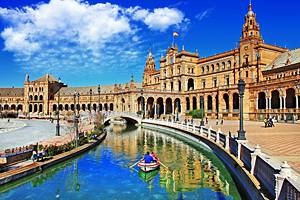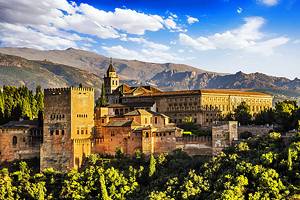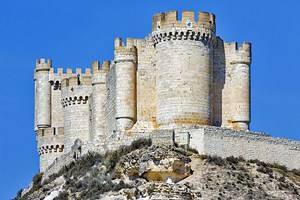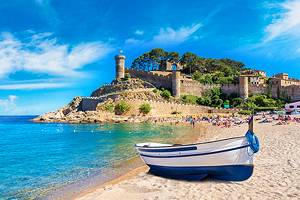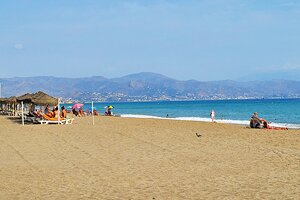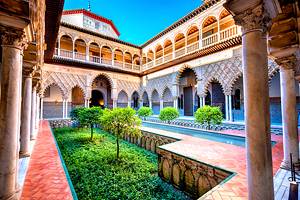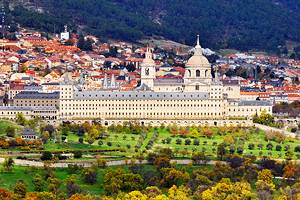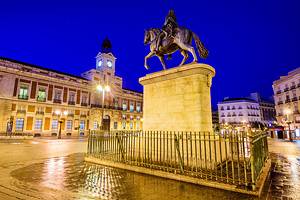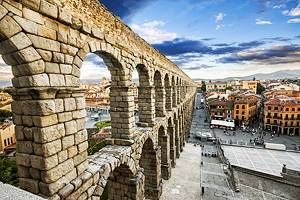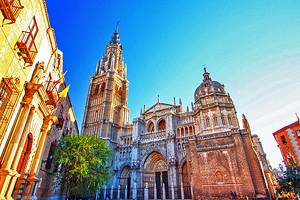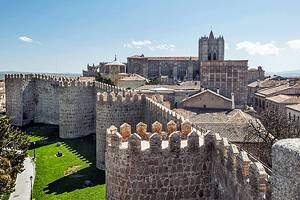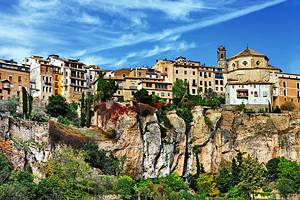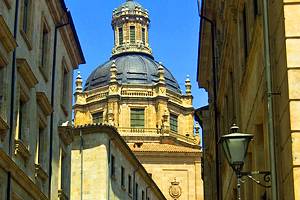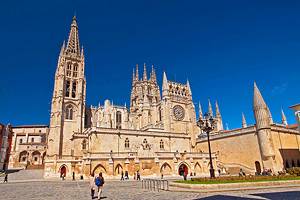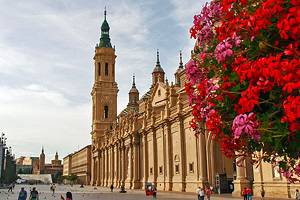Places to Visit in Northern Spain
Northern Spain extends from the Mediterranean Sea to the Atlantic Ocean, bounded by the Pyrenees Mountains at the border with France. With its diverse landscapes and distinct provinces, this beautiful area of Spain offers something for every type of traveler.
The energetic, culture-packed city of Barcelona has fabulous art museums and fantastic architecture. San Sebastián is an elegant beach resort with a quaint Old Town and an outstanding restaurant scene. The ultimate destination of the medieval Way of Saint James pilgrimage, Santiago de Compostela immerses visitors in the spiritual ambience that has animated the city for a millennia.
Besides Barcelona's Gaudí monuments and Santiago de Compostela's historic center, other UNESCO World Heritage sites are scattered throughout northern Spain, including a breathtaking cathedral in Burgos, the Roman ruins of Tarragona, pre-Romanesque churches near Oviedo, and the Ordesa and Monte Perdido Natural Park in the Huesca province.
Travelers searching for a soul-inspiring experience should take a journey to the remote Monastery of Montserrat. For picturesque fishing villages and coastal scenery, the Costa Brava in Catalonia is sure to impress. Thrill-seekers flock to Pamplona for its annual Running of the Bulls event, but the town itself is an interesting place to visit any time of year, and the nearby Navarra countryside has wonderful hiking trails.
Plan your Spanish sightseeing itinerary with our list of the best places to visit in Northern Spain.
- Barcelona
- San Sebastián & Hondarribia
- Santiago de Compostela
- Seaside Resorts on the Costa Brava
- Bilbao
- Pamplona
- Tarragona
- León
- Burgos
- Girona
- Zaragoza
- Monastery of Montserrat
- Santander
- Oviedo
- Heusca Province
- Ponferrada
- La Coruña & Rías Altas Villages
- Santillana del Mar
- Picos de Europa Natural Park
- La Rioja Region
- Map of Places to Visit in Northern Spain
Barcelona

The sparkling crown jewel of Catalonia, the region's vibrant capital boasts an alluring seaside setting, fabulous Modernist architecture, and a delightful medieval quarter.
Visitors can soak up the city's ambience by strolling the bustling La Rambla boulevard, stopping at the colorful La Boqueria covered marketplace, getting lost in the narrow pedestrian streets of the Barri Gòtic, admiring the whimsical Gaudí monuments, and basking in the sun on sandy beaches.
Must-see tourist attractions include the Basílica de la Sagrada Família, created by Antoni Gaudí in his signature surrealistic style; the Picasso Museum in the Gothic Quarter; the Casa Milà and the Casa Batlló, UNESCO-listed buildings designed by Gaudí; and the Parc Güell, with its splendid landscaping and sweeping city vistas.
Barcelona is also well known for its gastronomy. Near the Casa Batlló is Moments restaurant, an award-winning fine-dining establishment within the Mandarin Oriental, Barcelona that has earned two Michelin stars and specializes in contemporary Catalan cuisine.
Within walking distance of the Museu Nacional d'Art de Catalunya in Montjuic is a gourmet destination run by renowned chef Albert Adrià. This trendy restaurant serves tasting menus in an intimate dining room that channels a fantastical modern speakeasy.
The surroundings of Barcelona appeal to travelers in search of a beautiful coastline, cute fishing villages, and culture-rich medieval towns. Popular day trips from Barcelona are the majestic hilltop Montserrat Monastery, the seaside resort of Sitges, and the Costa Brava beaches.
San Sebastián & Hondarribia

One of Spain's most stylish beach resorts, San Sebastián dazzles visitors with its dreamy natural scenery and refined urban elegance.
The town is ensconced along the Bahía de la Concha, a crescent-shaped bay that encloses a sheltered sandy beach, called La Perla. A spacious pedestrian promenade invites seaside strolls, while many shops and restaurants are found on the Alameda del Boulevard just steps away from the beach.
Among the highlights of San Sebastián are the 12th-century Castillo de la Mota on Monte Urgull, the Museo San Telmo (fine arts museum), and the Parte Vieja (Old Town), where locals and tourists enjoy wandering the cobblestone streets in search of authentic pintxos (Basque tapas) restaurants. San Sebastián is well known for its superb gastronomy.
For exceptional meals and stunning sea views, the Mirador de Ulía is a wonderful choice. This Michelin-starred restaurant serves traditional Basque cuisine, as well as vegetarian and vegan menus prepared from seasonal ingredients.
A worthwhile detour (about 20 kilometers from San Sebastián) is the Basque filling village of Hondarribia, which has a walled medieval Old Town and an expansive beach that is popular during summertime.
Renowned for its cuisine, Hondarribia is brimming with excellent restaurants helmed by top chefs, and authentic pintxos bars that serve Basque tapas. (Most of the restaurants and pintxos bars are found in the seaside Marina neighborhood.)
Santiago de Compostela

During the 11th and 12th centuries, Santiago de Compostela was Europe's most important pilgrimage destination. The faithful endured long, treacherous journeys by foot, from France, Spain, Portugal, and other European countries, to arrive at the hallowed Catedral de Santiago.
The Cathedral of Santiago de Compostela contains the Crypt of Saint James, the venerated tomb that is the ultimate pilgrimage object and explains why the pilgrimage routes are called the "Way of Saint James." Modern-day pilgrims still embark on the Camino de Santiago, following the medieval pilgrimage routes.
A marvelous example of early Romanesque architecture, the Cathedral of Santiago de Compostela is Spain's most important Christian monument. The ornate exterior blends the original 12th-century sculpted doorway with lavish Baroque twin towers, while the grandiose sanctuary offers a sense of serenity.
In the late 15th century, the Catholic Monarchs created the Hostal de los Reyes Católicos to provide lodging for pilgrims. Today, this gorgeous Gothic Plateresque building still welcomes overnight guests as the Parador Santiago de Compostela, considered to be the world's oldest hotel. This luxurious five-star hotel has magnificent reception halls, sumptuous guest rooms decorated in traditional style, and two restaurants that specialize in the cuisine of Galicia.
Other must-see attractions of Santiago de Compostela include the Old Town (Casco Antiguo) of Santiago de Compostela, around the Plaza del Obradoiro and the Hostal de Los Reyes Católicos. Designated as a UNESCO World Heritage Site, this pedestrianized area is an appealing jumble of narrow medieval streets, historic churches, and monasteries.
Santiago de Compostela is located in the Galicia region and is a good starting point to discover northern Spain's west coast, including La Coruña, Ferrol, and Cedeira.
Seaside Resorts on the Costa Brava

Rated as one of Spain's top beach destinations, the Costa Brava is a delightful stretch of coastline characterized by its rugged natural beauty and charming coastal villages. The Costa Brava extends along a hilly landscape for over 200 kilometers from Blanes to the border between Catalonia and France. Alongside the Mediterranean Sea, secluded golden-sand beaches are surrounded by cliffs and tucked into coves.
Popular beach resorts are found in Blanes, a historic town with expansive beaches; Tossa de Mar, a walled medieval town; Lloret de Mar, which has elegant gardens and pristine waters; and Santa Susanna prized for its wide sandy beaches backed by groves of fragrant pine trees.
Cadaqués is a quaint fishing village nestled on the Cadaqués Bay of the Cap de Creus (peninsula), a rocky coastline with sheer cliffs and peaceful coves. This historic whitewashed town attracted famous painters during the 20th century. Several art galleries and museums attest to the town's artistic heritage.
One of the houses in the Old Town of Cadaqués was the home of Salvador Dalí and is now the Salvador Dalí House - Portlligat Museum. Fans of Salvador Dali and surrealist art should also visit the Dalí Theatre-Museum in Figueres and the Gala Dalí Castle in Púbol.
Calella de Palafrugell has retained the feel of a small fishing village even though its sandy beaches get very crowded during summertime. Tourists also adore the old-world charm of the perched town of Begur overlooking the sea and L'Escala, which has an atmospheric historic quarter and Greek ruins from the 2nd-century BC at the Empúries archaeological site.
Water sports enthusiasts find plenty of things to do on the Costa Brava, from snorkeling to sailing and windsurfing. The uninhabited nature preserve of the Medes Islands (boat ride from L'Estartit) is a great place for snorkeling and scuba diving.
Perched on the Punta d'es Muts cliffs, a supremely picturesque spot on the Costa Brava, the Parador de Aiguablava (46 kilometers from Girona) affords panoramic vistas of the coastline and the Aiguablava Beach, where azure waters lap up against golden sandy shores. This contemporary-style resort hotel has an outdoor terrace, swimming pool, sauna, fitness center, and beachside restaurant that serves traditional cuisine of the region.
Bilbao

The spectacular modern architecture and avant-garde art of the Guggenheim Museum draw many visitors to Bilbao. This world-class museum was designed by the famous architect Frank Gehry. Masterpieces of modern and contemporary paintings and sculptures are presented in twenty galleries covering 24,000 square meters of exhibition space.
Another must-see museum among the top attractions of Bilbao is the Museo de Bellas Artes de Bilbao (Museum of Fine Arts), which displays a collection of European paintings from the 14th to 17th centuries. The Spanish Old Masters are well represented, including El Greco, Zurbarán, and Velázquez. There is also an assortment of paintings by Francisco de Goya.
Besides art and architecture, Bibao is renowned for its gastronomy. The city boasts six Michelin-starred restaurants, including Nerua at the Guggenheim Museum. For more casual and convivial dining, traditional pintxos (tapas) restaurants are the best choice.
Pamplona

Pamplona owes its fame to the religious festival in July, the Fiesta de San Fermín, devoted to the patron saint of the Navarra province, San Fermín. Although the Fiesta de San Fermin begins with a Catholic Mass at the Chapel of San Fermín and includes a traditional procession, it is the Running of the Bulls (El Encierro) event during the festival that really put Pamplona on the tourist map. The legendary event draws thrill-seeking visitors from all over the world.
For those who want to watch the Running of the Bulls from the safe space of a private balcony, the five-star Gran Hotel La Perla is a perfect choice. Some of the hotel's exterior rooms overlook the Calle de la Estafeta, where a portion of the Running of the Bulls course takes place.
When the festival crowds leave town, it's worth exploring the attractions of Pamplona, especially the Casco Viejo. Partially enclosed by medieval ramparts, this warren of narrow cobblestone streets and elegant squares is brimming with historic monuments: the Gothic and Neoclassical cathedral; the 16th-century citadel built by King Felipe II; the Plaza del Castillo, where locals hang out at sidewalk cafés; and the opulent Baroque town hall.
Outside Pamplona, the Navarra countryside is a paradise for nature lovers. The Parque Natural Urbasa-Andía (70 kilometers from Pamplona) is a lush mountainous terrain with scenic hiking trails.
Worthwhile detours in the Pamplona surroundings include the Museo Oteiza in the idyllic pastoral landscape of Alzuza (10 kilometers from Pamplona) and the 11th-century Monasterio de Leyre (50 kilometers from Pamplona), which holds church services, including Gregorian chants, and also has a small hotel, the two-star Hotel Hospedería de Leyre, with a traditional Spanish restaurant.
Tarragona

The sun-soaked seaside city of Tarragona seems to have it all: stunning coastal scenery, alluring old-world ambience, and fascinating historic monuments.
The setting couldn't get much better than Tarragona's, along the Catalonian Costa Dorada (the Golden Coast), named for its fine sandy beaches. Playa El Milagro is a lovely beach within easy walking distance of the historic center of town.
Tarragona has been designated as a UNESCO World Heritage Site, because of its archaeological structures. Modern-day Tarragona was built above remains of the Roman-era city of Tárraco. The Roman ruins reveal an ancient town that was well planned, with a port, forum, theater, aqueduct, and defensive fortifications.
The most impressive site is the 2nd-century AD Roman amphitheater that overlooks the Mediterranean. Built during the reign of Emperor Augustus, this enormous stadium was designed to seat an audience of 12,000 spectators.
León

Remarkable historic monuments distinguish León, which displays its impressive heritage through architectural masterpieces such as a 10th-century Romanesque church, an Early Gothic cathedral, and a Spanish Plateresque monastery. In addition to the amazing landmarks, the charming Old Town (Casco Antiguo) and several top-notch museums provide enough cultural attractions to keep visitors busy.
For atmospheric dining, locals and tourists alike head to the Plaza Mayor (public square). Enclosed by 17th-century Baroque buildings, this elegant square is the center of the city and a hub of social activity. Within the square's arcaded buildings are several restaurants, many of which have terraces that spill out onto the sunny square.
The Plaza Mayor hosts a traditional, open-air farmers market on Wednesday and Saturday mornings.
Within a short walk from the Plaza Mayor is the Palacio del Conde Luna, a 14th-century Gothic-Mudéjar palace that was the residence of the valiant Count Luna. The palace served as a court during the Spanish Inquisition. Today, the Palacio del Conde Luna is a museum that presents exhibits of León's history.
A truly special place to spend the night is at the luxurious Parador de León. This five-star hotel occupies the 16th-century Convento de San Marcos, considered a gem of Spanish Plateresque style and one of the most important Renaissance monuments in Spain.
Since the 12th century, this convent has welcomed pilgrims on the way to Santiago de Compostela. However, the original building was reconstructed in the 16th century by the Catholic Monarchs. Hotel amenities include a concierge, garden, sun terrace, and a gastronomic restaurant that specializes in traditional cuisine of the Castile-León region.
Burgos

Spanish Gothic architecture finds perfect expression in the magnificent Catedral de Burgos. This soaring UNESCO-listed monument features an extravagantly decorated twin-towered exterior and an immense interior of breathtaking proportions, which makes it the third-largest church in Spain after the cathedral of Seville and Toledo.
Other must-see sights in Burgos include the ancient hilltop Castillo (castle) and the Monasterio de las Huelgas, an austere 12th-century Cistercian monastery built in the Mudéjar style and later converted to a Royal Pantheon.
Burgos has been welcoming visitors since the Middle Ages, when pilgrims stopped here on the Way of Saint James route to Santiago de Compostela. The town's legendary Christian heritage imbues the place with a special ambience, while historic buildings and cobblestone streets add to the old-world charm.
Along the riverbanks is a pleasant tree-shaded promenade, and nearby are many inviting restaurants.
Girona

An enchanting medieval city in the Catalonia region, Girona packs an incredible wealth of attractions into the historic areas within its ancient walls. The Força Vella follows the outline of a Roman fortress dating to the 1st-century BC (portions of the ramparts are still visible), while the walled Medieval Quarter is a maze of narrow, winding pedestrian streets and hidden squares.
The rich multicultural heritage of Girona can be discovered through its remarkable monuments, including a Romanesque basilica, the Gothic convent of Sant Doménech, and 12th-century Arab Baths. Girona also has a well-preserved Jewish Quarter.
Zaragoza

Steeped in two millennia of history, Zaragoza is the capital of the Aragon region and has a fascinating multicultural heritage. Splendid old monuments reveal the legacy of Roman, Moorish, Jewish, and Christian civilizations.
The remnants of ancient Roman walls are found in the city center, and two museums contain archaeological sites dating to the 1st century AD (including the Roman Theater and the Roman Forum). Several historic churches exemplify Aragon Mudéjar architecture, influenced by the geometric details of Islamic design.
Presiding over the banks of the Ebro River, the Basílica de Nuestra Señora del Pilar is the city's most iconic landmark. This exuberant Baroque building was built in the 17th and 18th centuries. A noteworthy fresco by Goya titled Queen of Martyrs adorns the interior.
Zaragoza is also known for its cultural events and gastronomy. The local cuisine features hearty regional dishes such as pan-fried trout, huevos en salmorejo (baked eggs with sausage), and bacalao al ajoarriero (salted cod fish in tomato and garlic sauce).
The biggest festival, the Fiestas del Pilar, takes place in mid-October to celebrate the feast of the city's patron saint, the Virgin del Pilar. A mass is held on October 12th, and the festival continues for a week with music concerts, puppet shows, dance performances, fireworks, and a parade.
Monastery of Montserrat

As early as the year 1025, Montserrat Mountain was the site of a little hermitage devoted to Santa Maria de Montserrat. Soon after it was founded, the monastery became associated with miracles. Faithful pilgrims have traveled here for a thousand years. The basilica's main object of adoration is the Romanesque Black Madonna (Our Lady of Montserrat), a 12th-century sculpture called La Moreneta.
The Monastery of Montserrat still functions as a working monastery (approximately 80 Benedictine monks live here) and continues to be an important pilgrimage site. The monastery's difficult-to-access location creates the sense of being a world apart. However, it is easy to get here thanks to a cable car (Aeri) that conveys visitors on a 1,350-meter journey to the top of the mountain.
As one of Catalonia's top tourist attractions, the Monastery of Montserrat is well prepared to welcome visitors. The monastery grounds include a basilica, a noteworthy art collection at the Museum of Montserrat, and several shops. Tourists will appreciate the meal options, including a food market that sells local products, two fine-dining restaurants, a casual cafeteria that offers buffet meals, and a picnic area.
Listening to the Escolania boys' choir sing at the basilica (which occurs daily) is an essential experience at the Monastery of Montserrat. Visitors may also participate in prayer services (mass and vespers), which are held several times a day. One of the shops at Montserrat sells CDs of the choir's musical sessions.
Montserrat Mountain is a place of serenity and sublime natural beauty, protected as a natural park. Many scenic hiking trails begin at the monastery and offer spectacular panoramic views of the Catalonian countryside.
Santander

The sophisticated city of Santander nestles on a small peninsula between the Cantabrian Sea and a wide bay. This picturesque coastline is prized for its soft sandy shores and crystalline turquoise waters.
The city's main beach, the Playa del Sardinero, draws many vacationers during the sunny summer months. Another centrally located beach, the Playa del Magdelena has a shoreline of fine golden sand and an area for recreational sports.
Besides being a fun-loving holiday destination, Santander appeals to those who appreciate culture and history.
The Museo de Prehistoria y Arqueología has an exceptional archaeology collection, ranging from Paleolithic-era artifacts to Roman antiquities. Two other museums are dedicated to contemporary art: the Centro Botín and the Museo de Arte Moderno y Contemporáneo de Santander y Cantabria.
Santander's most beautiful architectural landmarks are the Palacio Real de la Magdelena (a royal palace built in 1911) and the medieval Catedral de Nuestra Señora de la Asunciónare. The cathedral features an exquisite 15th-century cloister and a somber 13th-century crypt.
Oviedo

A remarkable number of pre-Romanesque churches sets Oviedo apart from other historic towns in northern Spain. The architectural heritage speaks to the importance of this city as the 9th-century capital of the Asturias kingdom.
King Alfonso II chose the location in the rolling hills of the Picos de Europa mountains because the remoteness made the town less vulnerable to attacks from the Moors of Córdoba.
Today, visitors enjoy the peacefulness of Oviedo's natural landscape, as well as the historic ambience of the Old Town with its pedestrian lanes and inspiring architecture. Oviedo's striking, single-towered cathedral is considered one of the finest Gothic monuments in Spain.
Outside of Oviedo's historic center are three UNESCO-listed pre-Romanesque churches (built in the 9th and 10th centuries): the Iglesia de Santa Maria del Naranco, the Iglesia de San Miguel de Lillo, and the Iglesia de San Julián de los Prados.
Oviedo has noteworthy museums of fine arts and archeology, and the town is equally renowned for its gastronomy. Local cuisine of the Asturias region includes delicious specialties such as bean stew and braised chicken with peppers.
Heusca Province

The medieval town of Heusca captivates visitors with its labyrinth of narrow, winding streets and historic monuments, including an impressive 13th-century cathedral and 12th-century Romanesque church.
Heusca is a good base for exploring the UNESCO-listed Parque Nacional Ordesa y Monte Perdido in the Pyrenees Mountains, which is a great place for hiking and other outdoor sports. This national park features rushing rivers, lush canyons, dramatic gorges, and soaring rocky peaks.
Ponferrada

A formidable 12th-century castle stands guard over the historic town of Ponferrada, which was on the medieval pilgrimage route to Santiago de Compostela. The Knights Templar castle now houses a museum that presents the history of Ponferrada.
A short drive (20 kilometers) from Ponferrada in a tranquil valley is the ancient Monasterio de San Pedro de Montes, a rare example of pre-Romanesque architecture dating to the 7th century. The monastery's Romanesque church was renovated in the 18th century.
La Coruña & Rías Altas Villages

In the Galicia region, La Coruña is a historic port town with a bustling harbor and superb beaches. The city center, bordering the waterfront, is a captivating collection of winding streets, pleasant squares, and medieval churches.
The most iconic monument in La Coruña is the 1st-century Tower of Hercules, designated as a National Monument and a UNESCO World Heritage site.
La Coruña is also well known for its aquarium and restaurant scene. Many local establishments serve delicious meals, featuring regional cuisine based on fresh-caught seafood.
Nearby are the Rías Altas villages in the northern estuaries of the Galicia region. Some of the top destinations within easy driving distance are Betanzos, which has an interesting Old Town that is listed as an Historic-Artistic Site; Pontedeume, a picturesque seaside village; and Ferrol, a fishing village (and military port) that is known for its Easter celebrations.
For relaxing seaside accommodations, travelers will appreciate the Parador de Ferrol, which occupies a stately Galician-style mansion overlooking the waterfront. The traditional decor includes nautical touches. A gourmet restaurant treats guests to sea views and superb Galician cuisine, with specialties such as fish stew and filloas, a special type of crêpe prepared in the region.
Santillana del Mar

About a 30-minute drive from Santander is the lovely historic town of Santillana del Mar, which was a stop on the medieval pilgrimage route to Santiago de Compostela.
Santillana del Mar dates back to the 8th century, and the entire town center is designated as a National Monument. The 12th-century Collegiate Church of Santa María is remarkable for its sculpted facade and Romanesque capitals in the cloister.
Picos de Europa Natural Park

The Picos de Europa Natural Park delights visitors with its awe-inspiring scenery and refreshing mountain air. The Picos de Europa are the Cantabrian Mountains' highest peaks, and the 646-square-kilometer natural park covers terrain in the Asturias, Cantabria, and León provinces.
Dramatic alpine landscapes define the Picos de Europa. The terrain includes jagged mountain peaks, verdant valleys, deep gorges, pristine rivers and lakes, and dense woodlands.
Three distinct massifs form the Picos de Europa mountain range. The loftiest, Urriellu Peak (the central massif, also known as the "Naranjo de Bulnes"), reaches an elevation of 2,648 meters. The Urriellu Peak is a legendary destination for mountaineering and rock climbing in Northern Spain.
The enchanting mountain village of Bulnes on the Urriellu Peak may be reached by hiking up a steep pedestrian path or by taking a funicular railway from the town of Poncebos.
Another charming village in the Picos de Europa is Potes, built up along the rushing Quiviesa River. The village has many historic bridges that span the river, as well as old buildings that date back to the 14th and 15th centuries. The area around Potes is popular for hiking, fishing, and mountain biking.
Also not to be missed, the town of Cangas de Onís is nestled alongside the Sella River in the valley of the Picos de Europa. The town boasts an ancient Roman Bridge and a chapel that stands on the site of an 8th-century hermitage.
La Rioja Region

La Rioja is a gorgeous region in Northern Spain, prized for its idyllic scenery of vine-covered rolling hills and lush oak forests. The region also has a rich cultural heritage, linked with the medieval Camino de Santiago pilgrimage route to Santiago de Compostela.
The town of Santo Domingo de la Calzada reveals the legacy of the medieval pilgrims. In the 12th century, Santo Domingo de la Calzada offered lodging for pilgrims at a hostel (now converted to the four-star Parador de Santo Domingo de la Calzada), and its cathedral provided a place for pilgrims to pray. The entire town, with its narrow stone-paved streets and attractive squares, is classified as a National Historic Interest Site.
Another destination tied to the Way of Saint James (Camino de Santiago) pilgrimage route is the town of San Millán de la Cogolla, tucked away in a valley traversed by the Cárdenas River. San Millán de la Cogolla has two UNESCO-listed monuments: the Monastery of Suso (built between the 6th and 11th centuries), which blends Visigothic, Mozarab, and Romanesque architectural styles, and the Monastery of Yuso, an 11th-century Romanesque monument.
Map of Places to Visit in Northern Spain
More Related Articles on PlanetWare.com
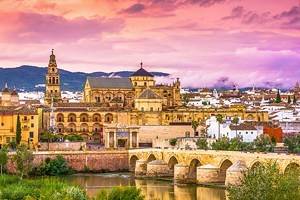
Other Top Destinations in Spain: With so many cultural treasures, Spain gives travelers endless reasons to extend a vacation. Among the best places to visit in Spain are the capital city of Madrid and the cultured port town of Valencia on the Mediterranean Sea. The UNESCO-listed Old Town of Segovia and the historic city of Toledo fascinate visitors with their marvelous Gothic monuments that seem out of a fairy tale.
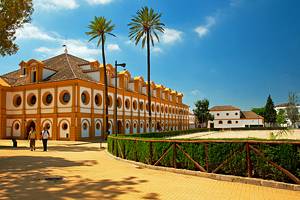
Highlights of Southern Spain: Steeped in the legacy of its multicultural past, Andalusia is an emblematic region famous for flamenco, festivals, and a sociable spirit. Granada boasts amazing Islamic architecture seen in the UNESCO-listed Alhambra palaces and Generalife gardens. Córdoba dazzles visitors with its 8th-century Great Mosque, another UNESCO World Heritage site. The romantic city of Seville is home to the largest Gothic church in the Christian world, as well as a medieval Moorish palace.


